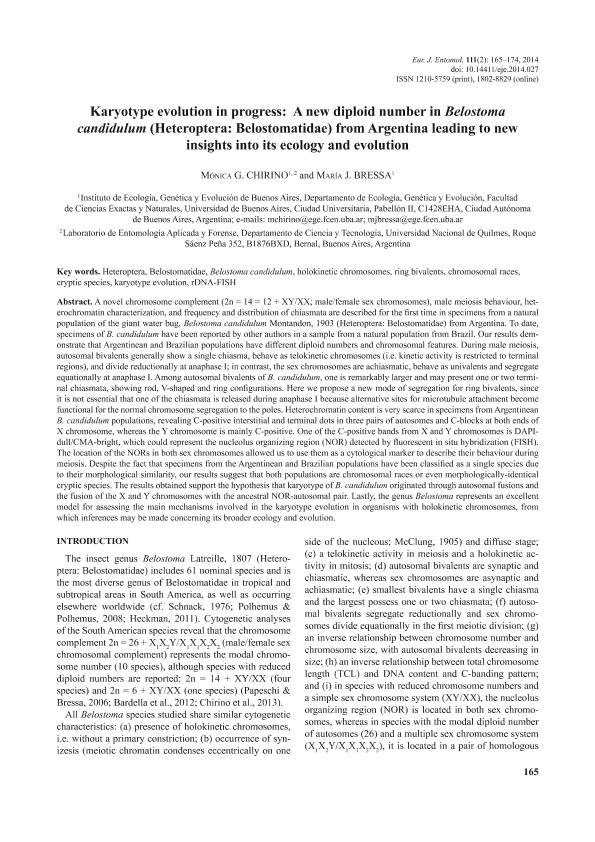Artículo
Karyotype evolution in progress: A new diploid number in Belostoma candidulum (Heteroptera: Belostomatidae) from Argentina leading to new insights into its ecology and evolution
Fecha de publicación:
05/2014
Editorial:
Czech Academy of Sciences
Revista:
European Journal of Entomology (Ceske Budejovice)
ISSN:
1210-5759
Idioma:
Inglés
Tipo de recurso:
Artículo publicado
Clasificación temática:
Resumen
A novel chromosome complement (2n = 14 = 12 + XY/XX; male/female sex chromosomes), male meiosis behaviour, heterochromatin characterization, and frequency and distribution of chiasmata are described for the first time in specimens from a natural population of the giant water bug, Belostoma candidulum Montandon, 1903 (Heteroptera: Belostomatidae) from Argentina. To date, specimens of B. candidulum have been reported by other authors in a sample from a natural population from Brazil. Our results demonstrate that Argentinean and Brazilian populations have different diploid numbers and chromosomal features. During male meiosis, autosomal bivalents generally show a single chiasma, behave as telokinetic chromosomes (i.e. kinetic activity is restricted to terminal regions), and divide reductionally at anaphase I; in contrast, the sex chromosomes are achiasmatic, behave as univalents and segregate equationally at anaphase I. Among autosomal bivalents of B. candidulum, one is remarkably larger and may present one or two terminal chiasmata, showing rod, V-shaped and ring configurations. Here we propose a new mode of segregation for ring bivalents, since it is not essential that one of the chiasmata is released during anaphase I because alternative sites for microtubule attachment become functional for the normal chromosome segregation to the poles. Heterochromatin content is very scarce in specimens from Argentinean B. candidulum populations, revealing C-positive interstitial and terminal dots in three pairs of autosomes and C-blocks at both ends of X chromosome, whereas the Y chromosome is mainly C-positive. One of the C-positive bands from X and Y chromosomes is DAPI-dull/CMA-bright, which could represent the nucleolus organizing region (NOR) detected by fluorescent in situ hybridization (FISH). The location of the NORs in both sex chromosomes allowed us to use them as a cytological marker to describe their behaviour during meiosis. Despite the fact that specimens from the Argentinean and Brazilian populations have been classified as a single species due to their morphological similarity, our results suggest that both populations are chromosomal races or even morphologically-identical cryptic species. The results obtained support the hypothesis that karyotype of B. candidulum originated through autosomal fusions and the fusion of the X and Y chromosomes with the ancestral NOR-autosomal pair. Lastly, the genus Belostoma represents an excellent model for assessing the main mechanisms involved in the karyotype evolution in organisms with holokinetic chromosomes, from which inferences may be made concerning its broader ecology and evolution.
Archivos asociados
Licencia
Identificadores
Colecciones
Articulos(IEGEBA)
Articulos de INSTITUTO DE ECOLOGIA, GENETICA Y EVOLUCION DE BS. AS
Articulos de INSTITUTO DE ECOLOGIA, GENETICA Y EVOLUCION DE BS. AS
Citación
Chirino, Monica Gabriela; Bressa, Maria Jose; Karyotype evolution in progress: A new diploid number in Belostoma candidulum (Heteroptera: Belostomatidae) from Argentina leading to new insights into its ecology and evolution; Czech Academy of Sciences; European Journal of Entomology (Ceske Budejovice); 111; 2; 5-2014; 165-174
Compartir
Altmétricas




